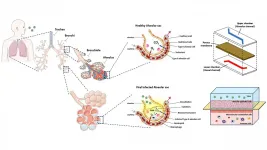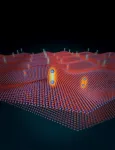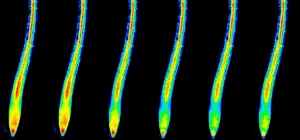Microchip models of human lungs enable better understanding of disease, immune response
Lung-on-a-chip platforms can provide a more rapid alternative for preliminary testing of drug candidates to treat coronavirus-induced lung infections
2021-03-23
(Press-News.org) WASHINGTON, March 23, 2021 -- According to the National Institutes of Health, respiratory viruses are the most frequent cause of disease and death in humans, a fact highlighted by the COVID-19 pandemic. Despite the potential to cause severe disease, over 70% of viral infections remain asymptomatic.
Animal models have been used widely to understand how these viruses infect the host and how the host responds to prevent infection and onset of diseases. Data based on animal models, however, does not always apply well to humans, given the variability in species and genetics.
In Biomicrofluidics, by AIP Publishing, researchers from Ege University and the University of Nottingham review a range of lung-on-chip technologies that represent the vital properties of lung tissue and are capable of recapitulating the fundamental aspects of various pathologies.
"Lung-on-chip platforms are able to reconstruct the multicellular architecture, the physiochemical microenvironment, and the tissue-tissue interface of the human lung in vitro," said author Ozlem Yesil-Celiktas.
The researchers reviewed various state-of-the-art lung-on-chips and their applications in examining, diagnosing, and treating human viruses, including the coronavirus that causes COVID-19. Different platforms focus on different parts of the lung functions, such as small airway-on-chips and lung alveolus chips.
The knowledge and expertise accumulated through the development of physiologically relevant lung-on-chip models paves the way to use these models to study the interaction of several human respiratory viruses with the airway epithelium and alveolus in an organ-relevant setting.
"The current pandemic, which spread to almost every continent in just a few months, makes us realize how much we need a practical, humanized platform to expedite the trials for potential antiviral drugs and vaccines," said Yesil-Celiktas.
Considering new research showing one of the aftereffects of COVID-19-related pneumonia is pulmonary fibrosis, the lung-on-chip systems, which focus on lung fibrosis, enable a deeper understanding of disease mechanisms and related immune and technological responses.
Despite the advantages, the lack of vascularity and integration with external immune cells means these organ-chip platforms require the integration of these components to the microchips, not only for viral infections but also for other pathologies.
Going forward, the researchers will integrate modular sensing apparatus to provide online monitoring opportunities along with diagnostic outcomes. Such biomimetic systems also enable high-resolution and real-time imaging, as well as in vitro toxicological analysis or measurements of metabolic activities of living cells.
INFORMATION:
The article "Human lung-on-chips: Advanced systems for respiratory virus models and assessment of immune response" is authored by Ecem Saygili, Ece Yildiz-Ozturk, Macauley J. Green, Amir M. Ghaemmaghami, and Ozlem Yesil-Celiktas. The article will appear in Biomicrofluidics on March 23, 2021 (DOI: 10.1063/5.0038924). After that date, it can be accessed at https://aip.scitation.org/doi/10.1063/5.0038924.
ABOUT THE JOURNAL
Biomicrofluidics rapidly disseminates research in fundamental physicochemical mechanisms associated with microfluidic and nanofluidic phenomena. The journal also publishes research in unique microfluidic and nanofluidic techniques for diagnostic, medical, biological, pharmaceutical, environmental, and chemical applications. See https://aip.scitation.org/journal/bmf.
[Attachments] See images for this press release:

ELSE PRESS RELEASES FROM THIS DATE:
2021-03-23
What The Study Did: Employees of a health care system were surveyed on the eve of vaccine distribution to encourage them to receive a COVID-19 vaccine, assess their intentions to do so and understand reasons for hesitancy.
Authors: Michelle N. Meyer, Ph.D., J.D., Center for Translational Bioethics and Health Care Policy at the Geisinger Health System in Danville, Pennsylvania, is the corresponding author.
To access the embargoed study: Visit our For The Media website at this link https://media.jamanetwork.com/
(doi:10.1001/jamanetworkopen.2021.5344)
Editor's Note: Please see the article for additional information, including ...
2021-03-23
What The Study Did: This study of working-age people enrolled in private health plans from March 2019 through June 2020 documented patterns of care at the onset of COVID-19.
Authors: Jonathan P. Weiner, Dr.P.H., Johns Hopkins Bloomberg School of Public Health in Baltimore, is the corresponding author.
To access the embargoed study: Visit our For The Media website at this link https://media.jamanetwork.com/
(doi:10.1001/jamanetworkopen.2021.2618)
Editor's Note: The article includes funding/support disclosures. Please see the article for additional information, ...
2021-03-23
What The Study Did: Researchers investigated representation of Black Americans in clinical trials of cardiovascular drugs approved by the U.S. Food and Drug Administration between 2006 and 2020.
Authors: Jiarui Li, M.D., of the Chinese Academy of Medical Sciences and Peking Union Medical College in Beijing, China, is the corresponding author.
To access the embargoed study: Visit our For The Media website at this link https://media.jamanetwork.com/
(doi:10.1001/jamanetworkopen.2021.2640)
Editor's Note: Please see the article for additional information, including other authors, author contributions and affiliations, conflict of interest and financial disclosures, and funding and support.
INFORMATION:
Media ...
2021-03-23
CABI-led Plantwise plant clinics can help promote more sustainable ways to fight crop pests and diseases in Rwanda and Zambia - such as the fall armyworm - with the judicial use of pesticides within Integrated Pest Management (IPM) plans.
Dr Justice Tambo, lead author of the study published in the journal Food Policy, surveyed 1,474 farm households in Rwanda and Zambia and found that although farmers who visit plant clinics show a higher probability of opting for pesticides for pest control, they do not use them intensively and are more likely to adopt safer and more sustainable alternatives.
The scientists, which include researchers ...
2021-03-23
Denver--March 26, 2021---A lymph node collection kit can help surgeons attain compete resection and improve long-term survival after curative-intent lung cancer surgery, according to a study published in the Journal of Thoracic Oncology Clinical and Research Reports. The journal is published by the International Association for the Study of Lung Cancer.
Surgical resection is the most important curative treatment for non-small cell lung cancer (NSCLC). With successful implementation of lung cancer screening programs, the proportion of patients with NSCLC who undergo surgery is likely to increase significantly.
"However, poor surgical quality reduces the survival benefit of curative-intent surgery and suboptimal ...
2021-03-23
The discovery of the material graphene, which consists of only one layer of carbon atoms, was the starting signal for a global race: Today, so-called "2D materials" are produced, made of different types of atoms. Atomically thin layers that often have very special material properties not found in conventional, thicker materials.
Now another chapter is being added to this field of research: If two such 2D layers are stacked at the right angle, even more new possibilities arise. The way in which the atoms of the two layers interact creates intricate geometric patterns, and these patterns have a decisive impact on the material properties, as a research team from TU Wien and the University of Texas ...
2021-03-23
The possibly oldest cephalopods in the earth's history stem from the Avalon Peninsula in Newfoundland (Canada). They were discovered by earth scientists from Heidelberg University. The 522 million-year-old fossils could turn out to be the first known form of these highly evolved invertebrate organisms, whose living descendants today include species such as the cuttlefish, octopus and nautilus. In that case, the find would indicate that the cephalopods evolved about 30 million years earlier than has been assumed.
"If they should actually be cephalopods, we would have to backdate the origin of cephalopods into the early Cambrian period," says Dr Anne Hildenbrand ...
2021-03-23
Russian scientists have proposed a new algorithm for automatic decoding and interpreting the decoder weights, which can be used both in brain-computer interfaces and in fundamental research. The results of the study were published in the Journal of Neural Engineering.
Brain-computer interfaces are needed to create robotic prostheses and neuroimplants, rehabilitation simulators, and devices that can be controlled by the power of thought. These devices help people who have suffered a stroke or physical injury to move (in the case of a robotic chair or prostheses), communicate, use a computer, and operate household appliances. In addition, in combination with machine learning methods, neural interfaces ...
2021-03-23
In the hours after we die, certain cells in the human brain are still active. Some cells even increase their activity and grow to gargantuan proportions, according to new research from the University of Illinois Chicago.
In a newly published study in the journal Scientific Reports, the UIC researchers analyzed gene expression in fresh brain tissue -- which was collected during routine brain surgery -- at multiple times after removal to simulate the post-mortem interval and death. They found that gene expression in some cells actually increased after death.
These 'zombie genes' -- those that increased expression after the post-mortem interval -- were specific to one type of cell: inflammatory cells called ...
2021-03-23
Potassium is an essential nutrient for all living things. Plants need it in large quantities, especially for growth and in order to withstand stress better. For this reason, they absorb large quantities of potassium from the soil. In agriculture, this leads to a lack of available potassium in the soil - which is why the mineral is an important component in fertilizers. A team of German and Chinese researchers has now shown, for the first time, where and how plants detect potassium deficiency in their roots, and which signalling pathways coordinate the adaptation of root growth and potassium absorption ...
LAST 30 PRESS RELEASES:
[Press-News.org] Microchip models of human lungs enable better understanding of disease, immune response
Lung-on-a-chip platforms can provide a more rapid alternative for preliminary testing of drug candidates to treat coronavirus-induced lung infections






